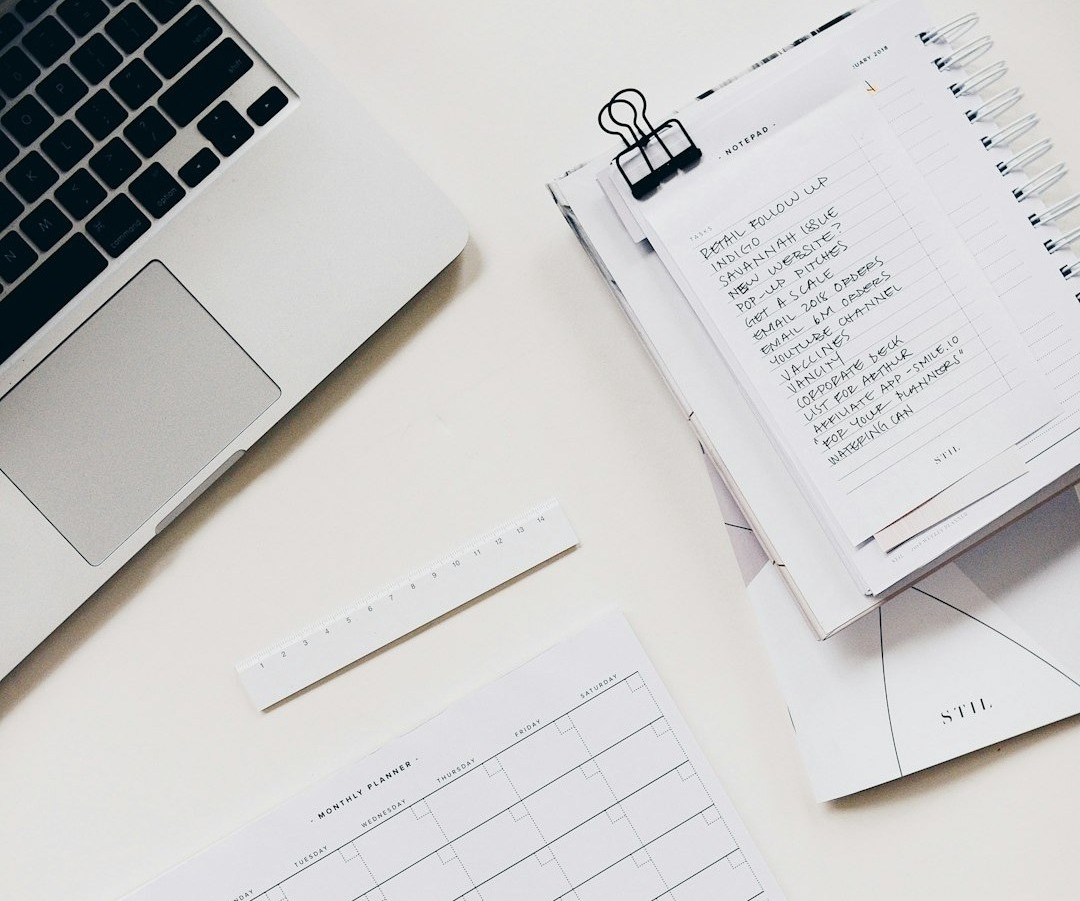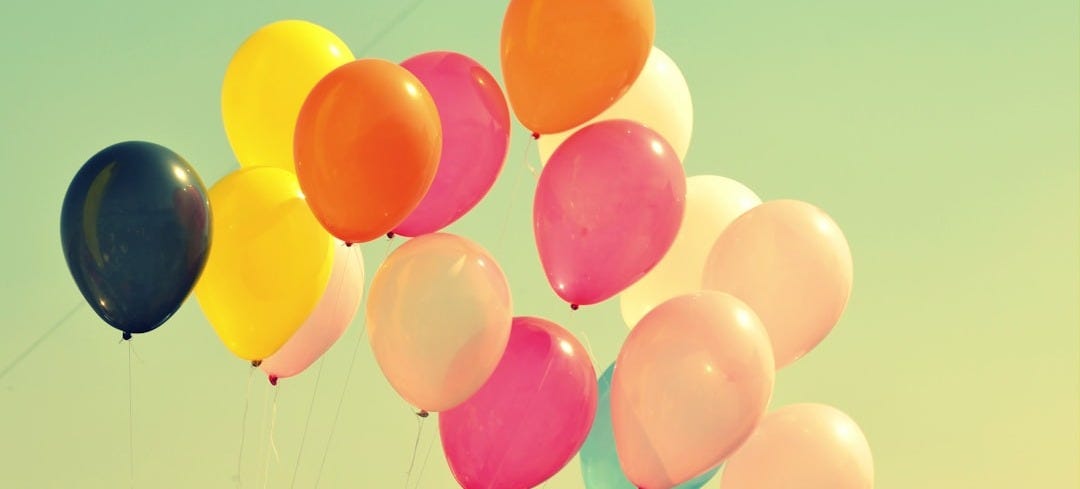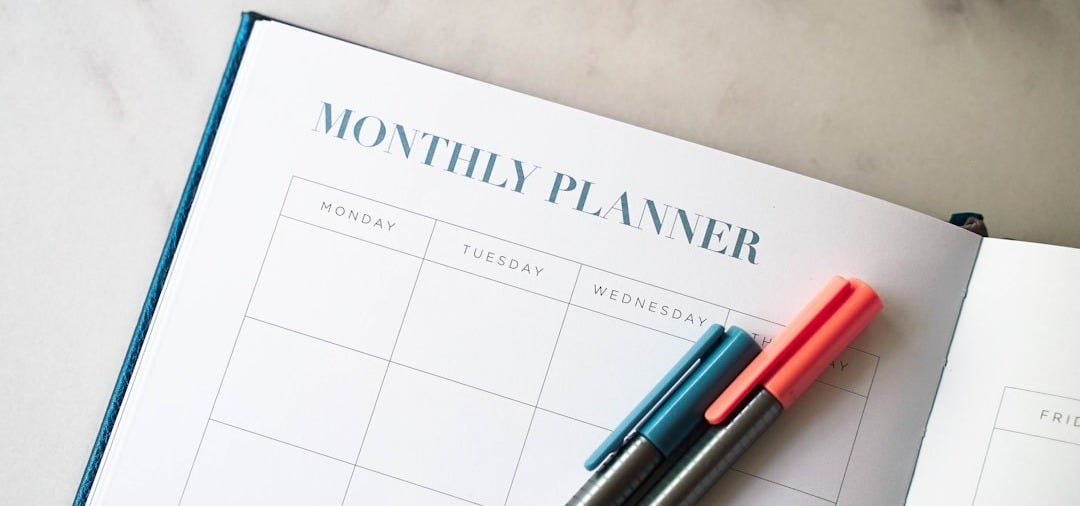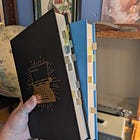How to Design Your Own Personal Curriculum
Borrow the best parts of academia and make them work for your personal growth. [ Detailed How-To + free PDF ]
It was a summer evening after the kids had gone to bed. When our college students are home, my husband and I have a routine of lounging on the couches with books or scrolling on social media for a bit. We often share what we read or whatever random video we find.
That night I saw this TikTok by @bookcasey.
Quick summary: She asked if anyone knows how to create a curriculum for furthering their own learning. She talked about being paralyzed by choice, not knowing where to start, and not knowing how to map it out.
* the original trend is from Elizabeth Jean
It was one of those posts that I thought about the next day and it sparked ideas within me to share here.
You all know that being intellectually alive has radically changed my life and given me a fresh perspective in mid-life. I went from being an angry mom to someone who makes space for hobbies and rediscovered deep joy in learning. This has changed my relationships, free time, and even my spending habits.
I enjoy making a life style of learning more approachable for others.
I got you if: you miss taking structured classes, you want to approach your personal learning in a more academic way, or you hope to reach a specific goal.
Post Overview:
- How to choose personal curriculum topics?
- Deciding how to divide up your time.
- Laying out the material in a sustainable way.
- Creating a syllabus / course map for the semester.
- Mapping out weekly goals.
- Celebrating milestones.
Choosing personal curriculum topics:
Similar to choosing a hobby, this process can be as unique as you are.
I recommend starting with what sparks your interest.
If you want to take a more academic approach I would begin with the basic subjects but add some whimsy to it.
📚 Literature
🏛 History & Culture
🔬 Science & Curiosity
➕ Math & Logic
✍️ Writing
🏃 PE & Wellness
🎨 Arts & Music
🌎 Languages & Life
🛠 Life Skills & Electives
adding some whimsy:
Hist 130: History Through Food — Explore a culture’s past by cooking its traditional recipes.
Lit 203: Page to Screen — Read famous books, then watch the movie adaptations (and argue which is better).
Sci 140: Citizen Scientist — Join projects that track stars, birds, or weather patterns.
Math 250: Coding as Problem Solving — Try beginner-friendly programming challenges.
Check out these free PDF lists I created!
The beauty of a personal curriculum is that there are no grades, deadlines, or finals. You can “enroll” in one or two classes this season and move at your own pace.
Action Step: Make a quick list of what grabbed your attention, then choose 2.
Divide up your time:
I have found that setting calendar specific personal goals helpful in actually making progress. I adjust my planning depending on my time constraints, caregiving tasks, and other commitments.
shorter sprints at about 6-8 weeks (one topic at a time during a busy season)
1 - 2 topics to focus on for the season (fall, winter, spring, summer)
academic style blocking (full semesters 15-18 weeks)
Action Step: What time frame works for your current schedule and planning?

Sustainable planning:
I find that no matter what I am learning about, having a home base keeps me focused.
I choose a specific book, YouTube channel, or reading list to keep me grounded in the subject. From there I can divide my time into chapters, categories, or books read.
Let’s work this out with an example.
Subject: 🖼️Sketching & Watercolor
Time Frame: 8 week sprint
Book: Draw Your Day by Samantha Dion Baker
Sustainable planning: In the Table of Contents there are 2 distinct sections to the book. “Getting Started” = 7 topics / “Ideas for Drawing” = 10 topics + drawing prompt. I could invest 45 min to 1 hour at 2 times per week and finish the book in about 8 weeks.
If I had more time during the week I could add in some YouTube tutorials based on the specific drawing prompt. (For example p.102 mentions architecture and perspective drawing.) Or I could stretch it to 10 weeks if the kids get sick or we have an out of town trip planned.
Action Step: What book (or other learning tool) will be your home base?
Creating a syllabus / course map:
In academia, a syllabus is essentially a roadmap for a class.
It sets expectations, outlines the learning journey, and helps both teacher and student know where they’re headed. You can borrow those same principles for a personal curriculum.
Key Elements of a Syllabus:
Course Objectives
What do you want to learn, practice, or experience by the end?
(e.g., “Be able to cook 5 new international dishes” or “Read 6 novels by women authors.”)
Course Materials
Texts, resources, tools, or supplies needed.
(Books, podcasts, trail maps, yoga mat, art supplies, etc.)
Schedule / Timeline
How long will this “course” last? A semester, a month, a season?
Break it down into weeks or modules for structure.
Assignments / Projects
What activities will you actually do?
(Weekly hikes, essays, recipes, sketches, journaling prompts.)
Assessment / Reflection
How will you know you’re learning or growing?
(Keep a log, write a reflection at the end, or share progress with a friend.)
Expectations & Workload
Set realistic time commitments (e.g., 2 hours/week vs. daily practice).
Define whether this is “serious study” or “light exploration.”
Policies - written with self kindness in mind
Grace Periods — It’s okay to pause when life gets full; you can always pick back up later.
Substitutions Welcome — Swap a book, project, or practice if your interest shifts.
Gold Stars Mindset — Showing up at all counts as a win; there’s no such thing as failure here.
Audit Option — Some weeks you might just “audit” by watching, reading lightly, or listening it’s still part of the journey.
Self-Care Clause — Rest, joy, and play all count as valid learning activities.
Flexible Attendance — Missing days or skipping assignments doesn’t erase your progress.
Action Step: Take a few minutes and journal out the answers to each of these areas above. Just quick, from the gut responses, nothing to elaborate.

Celebrating milestones:
Reaching milestones deserves to be noticed. It does not have to be a big event, but it helps to pause and see how far you have come.
Small or large, these markers remind you that the effort you put in is paying off.
Celebrating is also more meaningful when you share it. Invite a friend to join you for coffee and talk about what you learned. Share a photo of your finished project with your family. Treat yourself to a favorite meal or a slow day of rest.
The point is not to perform for others but to honor the progress and joy that comes with building your own personal curriculum.
A few ideas:
Host a “graduation lunch” — invite a friend or two to hear about what you’ve learned. Meet up for burgers and share your milestone.
Create a mini certificate — design a playful award for yourself and hang it where you’ll see it.
Share a progress post — write a short update in a journal, blog, or even a quick text to a friend.
Plan a themed night — watch a movie, cook a meal, or listen to music connected to what you just finished.
Treat yourself — buy fresh flowers, a new book, or enjoy a favorite dessert.
Take a reflection walk — head outside and think through what you gained from the experience. (bonus: journaling your thoughts after)
Mark your progress visually — add a sticker, doodle, or note on a calendar or in your planner.
Action Step: What will you do to mark significant milestones in this learning journey? Make a plan to involve others and celebrate in a simple way.

One of the frustrations of adulting is moving away from the academic year full of learning and new ideas and into endless careers and monotonous work days.
I have found that creating my own personal curriculum is a way back to joy and delight. It probably seems like “too much” to others. And that’s okay. It’s not for everyone or every season. But if you are inspired by this post I encourage you to try it out!
Start small and build a sustainable schedule.
Give yourself grace for when (not if) you get behind. Set backs do not erase your progress. Celebrate your wins, gold stars, and fun moments.
I dive deeper into ways to make space for personal growth in my book Subtle Resistance.
I am excited for you!
📝Happy Learning!
Check out these other favorite posts:
![April Edwards [Embracing Home]](https://substackcdn.com/image/fetch/$s_!LQC-!,w_80,h_80,c_fill,f_auto,q_auto:good,fl_progressive:steep,g_auto/https%3A%2F%2Fsubstack-post-media.s3.amazonaws.com%2Fpublic%2Fimages%2F35117ace-74f5-4db4-b7ac-543a660db102_1280x1280.png)
![April Edwards [Embracing Home]](https://substackcdn.com/image/fetch/$s_!e_Hp!,e_trim:10:white/e_trim:10:transparent/h_72,c_limit,f_auto,q_auto:good,fl_progressive:steep/https%3A%2F%2Fsubstack-post-media.s3.amazonaws.com%2Fpublic%2Fimages%2F8316051e-2315-4b00-bb18-b1ad0cb8d09f_1344x256.png)








I LOVE this! I started a commonplace journal because there are just so many things I learn and find fascinating. I keep telling myself that I’ll come back to these topics one day and explore them deeper, but I never do. This is such a clever way to structure that for myself!! Thank you!
this post has been so helpful, thank you so much for sharing!! I have been wanting to get started on a personal curriculum but I didn't know where to start!